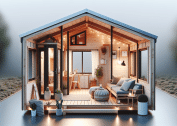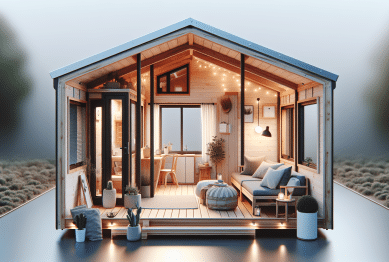Minimalist home design is more than just a passing trend. Explore how decluttering and purposeful living can create a peaceful, stunning space while supporting wellbeing and creativity. Uncover the secrets to embracing less for a more fulfilling lifestyle in this guide to minimalist interiors.
Why Minimalism Appeals to So Many Homes
The appeal of minimalist home design grows year after year. Many people find themselves attracted to the clean lines, neutral palettes, and open spaces that define minimalism. It’s not simply about having less—it’s about making more intentional choices in what fills the living area. Minimalist design often reduces distractions, helping households focus on what truly matters in daily routines. By incorporating minimalist principles, families frequently report feeling less overwhelmed by clutter and more centered in their environment. This transformation can be especially noticeable during hectic weeks, providing a sense of calm amid modern chaos.
A big part of minimalism’s popularity comes from the way it simplifies decision-making and day-to-day cleaning. Without extra knickknacks and tangled piles of possessions, cleaning becomes straightforward, and routine maintenance gets easier. Residents enjoy their living spaces for what they are, rather than working around excess stuff. Minimalism also encourages the selection of versatile, high-quality pieces over cheap, fast furniture—supporting sustainability and cost efficiency over time. This focus on quality resonates with both sustainability enthusiasts and lovers of timeless design.
People drawn to minimalist decor often seek a lifestyle that emphasizes wellbeing and intentionality. Whether renovating a single room or adopting a full minimalist lifestyle, the benefits extend beyond aesthetics. Studies suggest that decluttering can lower stress and create positive feelings towards one’s environment (Source: https://www.ncbi.nlm.nih.gov/pmc/articles/PMC5579396/). This movement isn’t just about furniture placement—it’s a complete mindset shift that can reshape how space is experienced every day.
Creating a Minimalist Space: The Essentials
Shifting to a minimalist home starts with the essentials. Most spaces begin with decluttering and a thorough evaluation of what truly adds value or joy. The process might seem challenging at first, but it gets easier as the benefits become clear. Minimalism does not mean living without—it means living with what brings purpose. Many experts suggest starting with shared spaces like living rooms, where visual clutter tends to accumulate. Sorting through books, decor, and furniture helps identify what can stay and what can be donated or recycled.
Functionality lies at the heart of a true minimalist space. The goal is to select furniture and items that serve multiple purposes. For example, a storage ottoman combines seating and hidden organization. Streamlined, neutral color palettes contribute to a calm and airy feel. Natural light, simple window treatments, and the use of plants create harmony in the space. Emphasizing these elements makes each room feel larger and more inviting, regardless of its size.
Choosing the right materials and finishes also contributes to the minimalist effect. Solid wood, linen, and ceramics provide understated beauty and texture without drawing undue attention. The focus remains on simplicity, utility, and tranquility. Every surface is easy to wipe clean, and possessions have dedicated places, reducing visual noise. This balance between practicality and beauty can make every day more enjoyable while promoting peace of mind (Source: https://www.health.harvard.edu/mind-and-mood/the-power-of-minimalism-in-everyday-life).
Benefits of Minimalist Living Beyond the Home
Adopting a minimalist home design often encourages greater mindfulness in other areas of life. Many discover that once their immediate surroundings support focus and relaxation, it’s easier to adopt healthy habits. Minimalism frequently inspires mindful consumption—people become more selective in purchases, focusing on what supports their life goals. This approach can reduce financial waste and often leads to improved savings over time (Source: https://www.consumerfinance.gov/about-us/blog/how-minimalism-can-support-financial-well-being/).
The reduction of emotional stress is another major benefit. According to research, a cluttered environment can negatively affect mental health and increase anxiety. With less to manage physically, many individuals report improvements in concentration, rest, and even relationships. The shift towards minimalist interiors can create room for hobbies and gatherings that truly matter, fostering deeper connections and greater satisfaction.
The eco-friendly aspect of minimalist living cannot be overlooked. Prioritizing fewer, higher-quality items supports a reduction in environmental impact. This lifestyle typically means less waste going to landfill and a greater appreciation for ethically sourced decor. For families and individuals interested in reducing their carbon footprint, minimalist choices offer a way to align household values with sustainability goals (Source: https://www.epa.gov/smm/sustainable-management-materials-households).
Common Myths and Misconceptions About Minimalism
Minimalism is sometimes misunderstood as a style that feels cold or sparse. In reality, successful minimalist spaces are warm, intentional, and deeply personal. The misconception comes from imagery of empty white rooms, which does not reflect the thoughtful curation seen in practical homes. Personal mementos, meaningful artwork, and comfortable textures can all play key roles in minimalist interiors without crowding the space.
Another myth is that minimalism is only for the wealthy. While some designer brands market minimalism at a premium, the philosophy’s foundation is accessibility and simplicity. Minimalist home design actually encourages saving money by focusing on quality over quantity and preventing unnecessary purchases. Thrift shops, repurposed heirlooms, and creative DIY projects fit seamlessly within this approach.
Some assume minimalism requires a massive lifestyle overhaul. In truth, incremental changes yield the best results. Many homeowners start with a single drawer or closet and expand over time. The key is gradual adjustment—learning to notice what is used and valued, then slowly letting go of what’s redundant. This process cultivates mindfulness and reduces anxiety associated with making big changes all at once (Source: https://www.psychologytoday.com/us/basics/minimalism).
Tips to Get Started with Minimalism at Home
Getting started with minimalist home design can be both exciting and manageable. The first step is to clarify your vision for the space. Many find it helpful to keep a minimalist inspiration board, featuring simple but inviting rooms, functional pieces, and natural elements. Setting a clear intention provides motivation and direction throughout the process. Organizing by category—such as clothing, books, or electronics—makes the decluttering phase less overwhelming and builds momentum.
Establishing daily or weekly habits can keep clutter under control. Setting aside just 10 minutes each evening to restore order prevents buildup. Keeping surfaces clear—kitchen counters, coffee tables, bedside stands—makes a surprising difference. For communal spaces, regular check-ins promote accountability among household members and ensure shared goals. Creating a home for every item makes tidying effortless and reduces friction over time.
For those worried about letting go, consider the benefit of each item. Does it truly serve a daily purpose, or does it linger out of habit? The transition to minimalism doesn’t have to be ruthless. Family heirlooms, gifts, and beloved books can be displayed mindfully instead of stored away. Sometimes, digitizing paperwork and photos helps preserve memories while reducing physical clutter. The result is a home that reflects personal values, supports wellness, and is easier to maintain (Source: https://www.verywellmind.com/simple-habits-for-a-calmer-home-4768055).
Long-Term Impact: The Minimalist Mindset
Beyond the physical space, minimalism encourages personal growth and adaptability. Over time, household members often find themselves applying minimalist principles to their schedules, routines, and relationships. The ability to release unnecessary obligations paves the way for more meaningful experiences. Minimalism fosters gratitude for what’s present and creates space—physically and emotionally—for future opportunities.
A minimalist mindset can also withstand life’s inevitable changes. Whether downsizing, moving, or welcoming new household members, those embracing minimalism typically navigate transitions with less stress. The habit of choosing essentials makes packing, organizing, and changing routines easier. Less stuff also means fewer distractions during major life moments, letting people savor milestones and memories more deeply.
This long-term approach has inspired entire communities and social movements (Source: https://minimalismfilm.com/). Gathering with like-minded individuals for inspiration, support, and ideas can turn the practice of minimalism into a source of connection and resilience. It’s not about deprivation—it’s about designing a life and home that truly feels like your own.
References
1. Saxbe, D. E., & Repetti, R. L. (2010). No Place Like Home: Home Tours Correlate With Daily Patterns of Mood and Cortisol. Retrieved from https://www.ncbi.nlm.nih.gov/pmc/articles/PMC5579396/
2. Harvard Health Publishing. (n.d.). The Power of Minimalism in Everyday Life. Retrieved from https://www.health.harvard.edu/mind-and-mood/the-power-of-minimalism-in-everyday-life
3. Consumer Financial Protection Bureau. (n.d.). How Minimalism Can Support Financial Well-Being. Retrieved from https://www.consumerfinance.gov/about-us/blog/how-minimalism-can-support-financial-well-being/
4. U.S. Environmental Protection Agency (EPA). (n.d.). Sustainable Management of Materials: Households. Retrieved from https://www.epa.gov/smm/sustainable-management-materials-households
5. Psychology Today. (n.d.). Minimalism. Retrieved from https://www.psychologytoday.com/us/basics/minimalism
6. Verywell Mind. (n.d.). 7 Simple Habits for a Calmer Home. Retrieved from https://www.verywellmind.com/simple-habits-for-a-calmer-home-4768055









